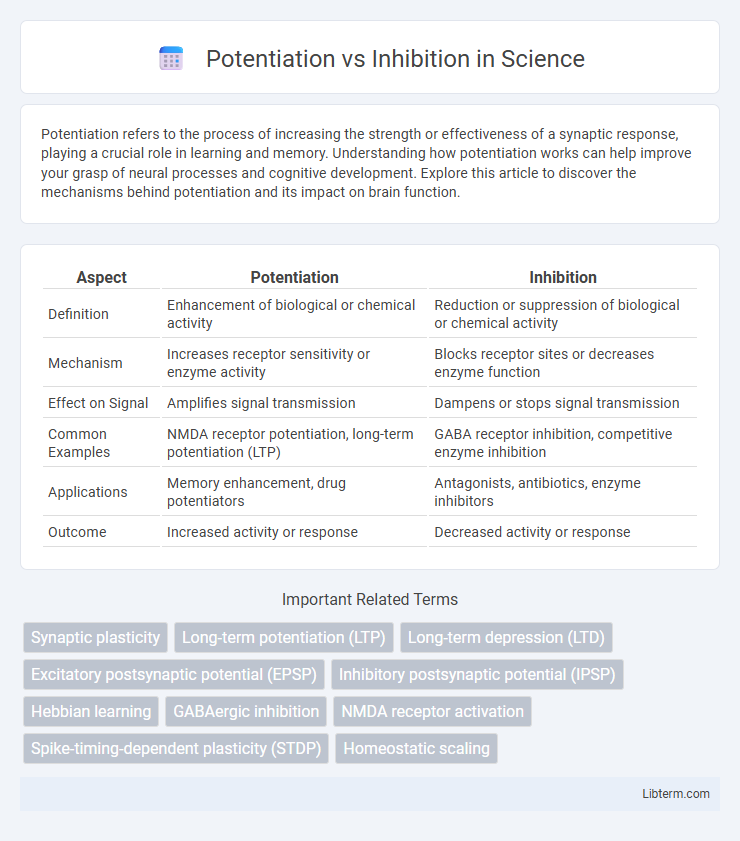Potentiation refers to the process of increasing the strength or effectiveness of a synaptic response, playing a crucial role in learning and memory. Understanding how potentiation works can help improve your grasp of neural processes and cognitive development. Explore this article to discover the mechanisms behind potentiation and its impact on brain function.
Table of Comparison
| Aspect | Potentiation | Inhibition |
|---|---|---|
| Definition | Enhancement of biological or chemical activity | Reduction or suppression of biological or chemical activity |
| Mechanism | Increases receptor sensitivity or enzyme activity | Blocks receptor sites or decreases enzyme function |
| Effect on Signal | Amplifies signal transmission | Dampens or stops signal transmission |
| Common Examples | NMDA receptor potentiation, long-term potentiation (LTP) | GABA receptor inhibition, competitive enzyme inhibition |
| Applications | Memory enhancement, drug potentiators | Antagonists, antibiotics, enzyme inhibitors |
| Outcome | Increased activity or response | Decreased activity or response |
Understanding Potentiation and Inhibition
Potentiation refers to the enhancement of a biological or chemical process, resulting in increased activity or effect, often seen in synaptic transmission where receptor response is amplified. Inhibition involves the reduction or suppression of a process, such as enzyme activity or neural signaling, leading to decreased function or response. Understanding potentiation and inhibition is crucial in pharmacology and neuroscience for manipulating receptor activities and developing targeted therapies.
Key Differences Between Potentiation and Inhibition
Potentiation enhances the effect of a stimulus or drug by increasing receptor activity or signal transduction, leading to amplified responses in biological systems. Inhibition reduces or suppresses receptor activity or enzymatic function, resulting in diminished physiological or biochemical effects. Key differences include potentiation's role in amplifying responses versus inhibition's function in decreasing or blocking activity, with distinct molecular mechanisms underlying each process.
Mechanisms Underlying Potentiation
Potentiation occurs through mechanisms such as increased neurotransmitter release, enhanced receptor sensitivity, and the strengthening of synaptic connections via long-term potentiation (LTP). This process often involves the activation of NMDA receptors, leading to calcium influx and subsequent signaling cascades that promote AMPA receptor insertion into the postsynaptic membrane. These molecular events enhance synaptic efficacy, facilitating improved neural communication and plasticity in the central nervous system.
How Inhibition Modulates Biological Processes
Inhibition modulates biological processes by blocking or decreasing the activity of enzymes, receptors, or ion channels, thereby controlling cellular signaling and metabolic pathways. This regulatory mechanism ensures proper homeostasis and prevents overactivation that could lead to conditions like neurotoxicity or inflammation. By selectively targeting specific molecules, inhibition fine-tunes physiological responses and maintains system balance.
Potentiation in Neural Pathways
Potentiation in neural pathways enhances synaptic transmission by increasing the strength and efficiency of signal propagation between neurons, often through mechanisms such as long-term potentiation (LTP). This process involves the upregulation of neurotransmitter receptors, particularly NMDA and AMPA receptors, facilitating greater calcium influx and synaptic plasticity essential for learning and memory. Potentiation modulates neural circuitry by reinforcing synaptic connections, thereby optimizing information processing and storage within the brain.
Role of Inhibition in Synaptic Transmission
Inhibition plays a crucial role in synaptic transmission by regulating neuronal excitability and maintaining the balance between excitation and inhibition within neural circuits. It primarily occurs through inhibitory neurotransmitters like GABA and glycine, which activate postsynaptic receptors to decrease the likelihood of action potential generation. This inhibitory control modulates synaptic strength, prevents excessive neuronal firing, and contributes to synaptic plasticity by counteracting potentiation mechanisms.
Potentiation vs Inhibition in Drug Action
Potentiation in drug action occurs when one drug enhances the effect of another, often by increasing receptor activity or enhancing signaling pathways, resulting in a synergistic therapeutic benefit. Inhibition involves one drug reducing or blocking the effect of another, frequently by competing for receptor sites or interfering with metabolic processes, which can diminish efficacy or reduce side effects. Understanding the balance between potentiation and inhibition is crucial for optimizing drug combinations, minimizing adverse interactions, and achieving desired pharmacological outcomes.
Clinical Significance of Balancing Potentiation and Inhibition
Balancing potentiation and inhibition is crucial in clinical settings to maintain optimal neural function and prevent neurological disorders such as epilepsy, schizophrenia, and anxiety. Effective therapeutic interventions often target this balance by modulating neurotransmitter systems, such as enhancing GABAergic inhibition or augmenting glutamatergic potentiation, to restore synaptic homeostasis. Disruption in this equilibrium can lead to cognitive impairments and affective disorders, highlighting the importance of precise pharmacological regulation for improved patient outcomes.
Examples of Potentiation and Inhibition in Physiology
Potentiation in physiology is exemplified by the facilitation of synaptic transmission, such as long-term potentiation (LTP) in the hippocampus, which enhances memory and learning by increasing synaptic strength. Inhibition is demonstrated by GABAergic synapses where gamma-aminobutyric acid (GABA) reduces neuronal excitability, crucial for preventing overstimulation and maintaining neural circuit balance. Both mechanisms regulate neuronal communication, with potentiation amplifying signals and inhibition dampening activity to coordinate physiological responses.
Future Directions in Potentiation and Inhibition Research
Future directions in potentiation and inhibition research emphasize the development of targeted therapies that modulate synaptic plasticity to treat neurological disorders such as Alzheimer's disease and epilepsy. Advances in optogenetics and neuroimaging techniques enable precise manipulation and real-time monitoring of neural circuits, facilitating deeper understanding of excitatory and inhibitory mechanisms. Integration of artificial intelligence in analyzing large-scale neural data promises to identify novel biomarkers and therapeutic targets for enhancing cognitive function and restoring neural balance.
Potentiation Infographic

 libterm.com
libterm.com